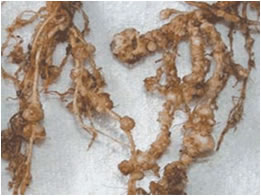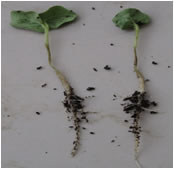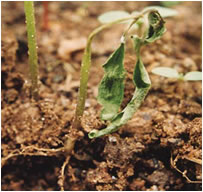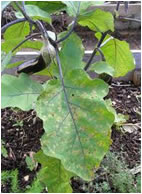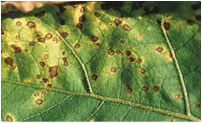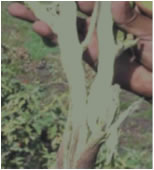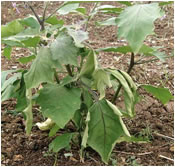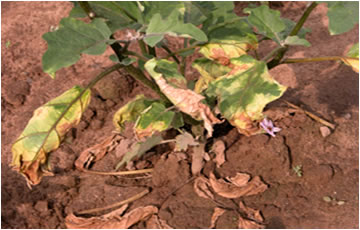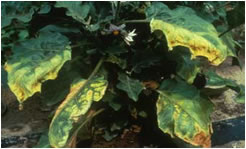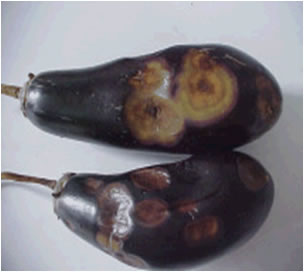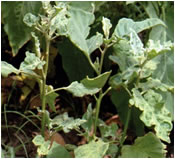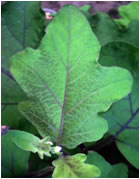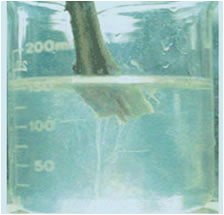
| Germination stage |
| Parts affected | Symptoms |
Management |
Image |
| Roots | • These are the most common plant parasitic nematodes (Meloidogyne spp.i.e., incognita, javanica) in India and infestation of these nematodes is common in brinjal. •The root knot nematode damage is more harmful to seedling than to older plants. |
• Removal and destruction of weed hosts and other host plants in and around the field. • Application of organic manure can reduce the nematode population • Field sanitation – removal of crop stubble and roots after harvesting • Crop rotation with non host crops • Leave the field fallow in the summer after two or three deep ploughings • Application of neem cake at 250kg/ha • Application of carbofuran 3 G @ 1 kg a.i./ha |
|
| Parts affected | Symptoms |
Management |
Image |
| Seedling | • Both the Pre-emergence and Post-emergence damping-off symtopms are seen in diseased state. • The germinating seeds are infected by fungi at the initial stages. • The infection later spreads to hypocotyls basal stem and developing roots. • The Post-emergence damping off phase is characterized by infection of the young, juvenile tissues of the collar at the ground level. • The affected seedlings become pale green and brownish lesions are found at the collar region, resulting in botting and topple over of seedlings. |
• Treat the seeds with Trichoderma viride 4g or Pseudomonas fluorescens 10g or captan 2g/kg of seed 24 hours prior to sowing. • Apply Pseudomonas fluorescens as a soil application @ 2.5 kg/ha mixed with 50 kg of FYM. • Prepare raised nursery beds and avoid stagnation of water. • Adopt recommended seed rate. • Drench the nursery with copper oxychloride 2.5 g/lit at 4 lit/sq.m. • Treat the seeds with captan 2g/kg of seed 24 hours before sowing. |
|
| Vegetative growth stage (30-60 days) |
| Parts affected | Symptoms |
Management |
Image |
| Leaves and stem | • The female moth lays eggs individually on the shoots of young brinjal plants. •The small larvae that emerge soon eat and bore inside the terminal shoots, resulting in the shoots withering •Bore holes on fruits are plugged with excreta rendering it unmarketable •Shedding of flower buds occur at flowering stage of the crop • As the brinjal plant develops and begins to produce fruit the female moth preferentially lays eggs on the fruit into which emerging larvae burrow. • Several larvae can be present in one fruit at a time, depending of the fruit's size. • As the larvae burrow into the fruit they block the hole with excrement or frass so preventing predators entering attacking them. |
• Infested shoots and fruits should be removed by hand fields, which is a sources of future infestation. • Shred or burnt crop residues before the next crop is planted in the fields. • Plough the field to reduce populations of soil borne pests and diseases. • Locate the nurseries as far from crop residues as possible. • In general insecticides should be avoided in order to preserve the natural enemies and predators that act to reduce the incidence of L. orbonalis and secondary pests such as T. curcurbitae. • Setting up of pheromone traps at 100/ha for mass trapping adult insects. • Apply carbaryl 50 WP 2g/l or endosulfan 35 EC 2ml/l or quinalphos 25 EC 2ml/l when the fruit damage exceeds 10%. |
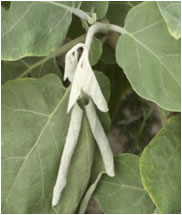 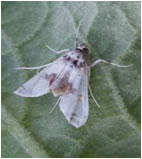 |
| Parts affected | Symptoms |
Management |
Image |
| Leaves and stem | • Yellow mining of leaves dult and larvae are polyphagous, feeding in a characteristic scraping manner on tomato, potato and brinjal leaves. |
• Collection and destruction of grubs and adults • Spray carbaryl 50 WP 3g/l or endosulfan, 35 EC 2ml/l or malathion 50EC 2ml/l. |
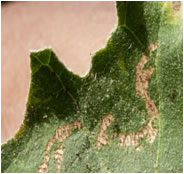 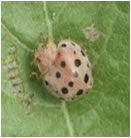 |
| Parts affected | Symptoms |
Management |
Image |
| Leaves, petioles, twigs, branches and fruits. | • Concentric rings on the leaves and fruits • Mosaic mottling on the leaves • Deformation of leaves |
• Spray mancozeb on the plants at 2g/lit |
|
| Parts affected | Symptoms | Management | Images |
| •Leaves, flower, stem and plant | • A serious viral disease of brinjal, transmitted by leaf hopper (Hishimonus phycitis) and Amrasca biguttula biguttula).
|
• The flower buds take an upright position instead of being pendulous. • Removal of infested plants and either burning or burying them. Failure to remove infested plants will allow the infestation time to spread to neighbouring plants. |
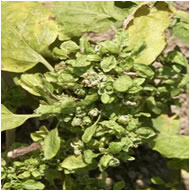 |
| Parts affected | Symptoms | Management | Images |
|---|---|---|---|
| Stems and leaves | • In Fusarium wilt, the underground stems become dry and brown as a result of cortical decay while roots may have soft and water soaked appearance. •Stunted growth, |
• Crop rotation with bhendi, tomato, potato should be avoided. • Soil application and foliar application with Benlate (0.1%). |
|
| Parts affected | Symptoms | Management | Images |
|---|---|---|---|
•The disease attacks the young plants as well as mature plants. |
• Crop rotation with bhendi, tomato, potato should be avoided.
|
|
| Parts affected | Symptoms |
Management |
Image |
| Leaves, petioles, twigs, branches and fruits. | • Small watersoaked lesions on the fruit, which later enlarges in size considerably. • Skin of infected fruit turns brown and develops white cottony growth. |
• Removal and destruction of the affected fruits • Spray Difolatan (0.3%) thrice at an interval of 10 days. |
|
| Fruit maturity stage (20-30 days) |
| Parts affected | Symptoms |
Management |
Image |
| Leaves, petioles, twigs, branches and fruits. | • Nymphs and adults feeds on cell sap from leaves causing chlorotic spots that result in yellowing and drying of leaves |
• Spray neem oil at 30 ml/lit + Teepol 1 ml/lit or neem seed kernel extract 50g/l of water. • Set up yellow sticky traps @ 12/ha to monitor the activity of the adults. |
|
| Parts affected | Symptoms |
Management |
Image |
| Leaves | • Flowers become phylloid. Axillary buds grow out into axillary shoots that in turn produce secondary and tertiary branches. • Eradicate solanaceous weed hosts in and around the field. • Remove and bury or burn affected plants in the early stages of disease development. |
• Spray malathion 1ml/lit or methyl demeton 2 ml/lit or dimethoate 2 ml/lit to control the insect vector. • Spray tetracycline @10-50ppm to prolong the incubation period and reduce sprouting of axillary buds. |
|
| Parts affected | Symptoms |
Management |
Image |
| Leaves, stems and fruits | • Mottling, vein-banding and clearing, and distortion. • Plants may be stunted with necrosis of the stems and apical buds. • Infected plants may show concentric rings on the foliage. • Affected fruits may be distorted, discolored and small. • Field plants are usually infected by more than one virus. • The leaves of infected plants are deformed, small and leathery. • Plants show a stunted growth when infected in the early stages. |
• The disease incidence can be minimised by reducing the population of aphids, • Removal and destruction of infected plants and eradication of susceptible weed hosts. • In the nursery, aphids can be controlled by application of Carbofuran (1 kg a.i./ha) in the nursery bed at the time of sowing seeds followed by 2-3 foliar sprays of Phosphamidon (0.05%) at an interval of 10 days. • Spraying Phosphamidon (0.05%) at 10 days interval starting from 15-20 days after transplanting effectively controls the aphids in the field. |
|
| Parts affected | Symptoms |
Management |
Image |
| Leaves, stems | • Wilting of the foliage followed by collapse of the entire plant. • The wilting is characterized by dropping and slight yellowing of leaves and vascular discolouration. • Drying of he palnts at the time of flowering and fruiting are also characteristic to the disease condition. • Milky white bacterial oozes coming out which is the diagnostic symptom for bacterial wilt when infected stem cut and dipped in water. |
• Crop rotation with bhendi, tomato, potato should be avoided. • Before sowing, the seeds should be dipped in a solution of Streptocycline (1 g/ 40 litres of water) for 30 minutes. |
|
![]()
Focus Districts
Gallery
